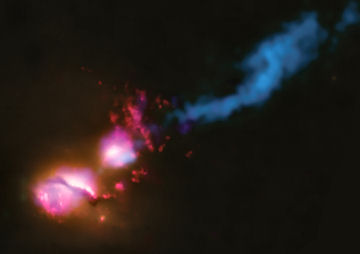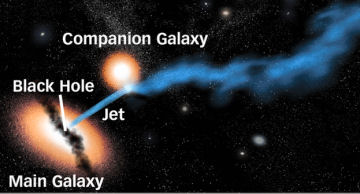- More than 2 years ago
War has been declared between two galaxies, and the future doesn’t look good for the underdog: The larger galaxy’s powerful jet of high-energy radiation and matter is hitting its helpless neighbor. Ambulance-chasing astronomers hope to take advantage of this cosmic drive-by shooting to learn more about the nature of such jets, which usually spurt into empty space.


The two galaxies, together called 3C321, lie 20,000 light-years apart but will eventually merge. Like most galaxies, both harbor supermassive black holes, strong centers of gravity that suck in any nearby matter. But only the larger galaxy produces a jet, a beam of energetic particles and radiation generated as matter swirls in toward the black hole.
“Jets like this move close to the speed of light and can travel vast distances,” says Dan Evans, leader of the study on 3C321. The larger galaxy once spewed X rays and gamma rays a million light-years into empty space, the scientists calculated. But then the neighboring galaxy moved into the line of fire, says Evans, of the Harvard-Smithsonian Center for Astrophysics in Cambridge, Mass.
“Now, the jet violently slams into the lower half of that neighboring galaxy,” he says. The result is like putting a hand in front of a hose shooting out water. The obstruction deflects the jet and slows it down.
Over time, Evans says, the jet will likely blast away the entire side of the smaller galaxy and regain its straight path. But in the meantime, the jet’s radiation will destroy the atmospheres and magnetospheres of any Earth-like planets in its way.
“We are talking about tens to hundreds of stars being in the path of this jet, and some of those stars likely have planets,” says co-investigator Martin Hardcastle of the University of Hertfordshire in the United Kingdom.
The jet’s destruction of the smaller galaxy might not last forever. The scientists hypothesize that eventually the jet could ram together some of the galaxy’s gases to create a star nursery.
To observe the deflection of the jet, scientists relied on a combination of images taken at different ranges in the electromagnetic spectrum. X rays, optical images, ultraviolet light, and radio emissions were used to create the final picture, which will appear in an upcoming Astrophysical Journal.
Studying the 3C321 system can help scientists understand not only the nature of the jet itself but also the surrounding space, says Neil deGrasse Tyson of the Hayden Planetarium in New York City.
“What I find fascinating about this work is it’s not just a jet and a galaxy,” says Tyson. “You see the interaction of the jet with the galaxy. And every time you see the jet do something different, it tells you something about the environment the jet entered.”







